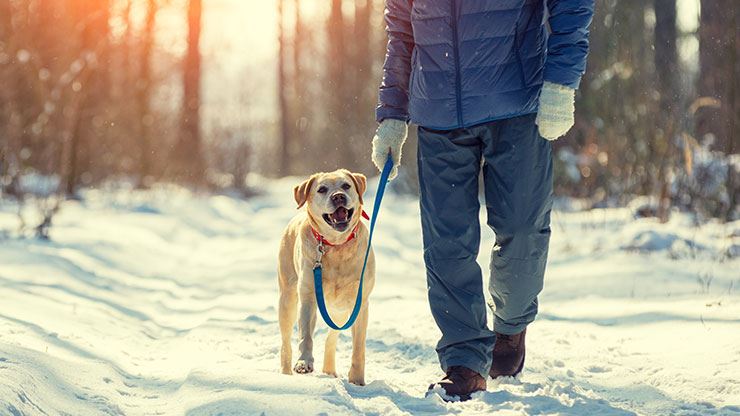
How to Prepare Your Dog for Winter
Winter is a season of joy, festivities, and cozy nights by the fireplace. However, it can also be a time of potential risks and challenges for our furry friends. As temperatures drop, ensuring your dog is well-prepared to face the cold months ahead is crucial. Here's a comprehensive guide to help you do just that.
Understanding Your Dog's Breed and Winter Tolerance
Not all dogs are created equal when it comes to tolerating cold. It's essential to understand your dog's specific needs based on their breed and adjust your care routine accordingly. For instance:
Thick-coated breeds like Saint Bernards and Newfoundlands have natural insulation against cold, but even they can suffer from prolonged exposure.
Short-haired breeds like Dalmatians or Boxers might struggle more in the cold and benefit significantly from added protection.
Understanding your dog's lineage can also provide insights. For instance, a mixed-breed dog might have some cold-resistant genes if one of its parents was a cold-tolerant breed.
Dietary Adjustments for Winter
Cold weather can increase a dog's energy requirements. Consider providing a little extra food during these months, especially if they spend a lot of time outdoors. High-quality dog foods and supplements can help support their overall health and energy levels during winter. As the cold sets in, dogs tend to burn more calories to stay warm. Here's how you can adjust their diet:
Increase Caloric Intake: Consider giving them a bit more food, especially if they're active outdoors.
Fatty Acids: Omega-3 and Omega-6 can help improve their coat's quality, providing better insulation.
Hydration: Ensure they have access to unfrozen water at all times. Dehydration can still occur in colder months.
Winter Wardrobe for Dogs
Just as we need warm clothing in winter, many dogs can benefit from a winter wardrobe. Dog sweaters and coats are especially beneficial for breeds with short or thin fur. Ensure the clothing fits well and doesn't restrict movement. Additionally, dog boots can protect their paws from cold surfaces, ice, and harmful chemicals like road salts.
Material Matters: Look for water-resistant materials that offer insulation.
Fit: Ensure the clothing fits snugly but doesn't restrict movement. It should cover the belly area, which is more exposed to cold.
Paw Protection: Dog boots protect against cold, salt, and other chemicals used to melt ice.

Grooming and Skin Care
Winter can be tough on a dog's skin and fur. Prevent matting, which can reduce fur's insulating properties, by brushing regularly. Moisturize their paws and noses to prevent cracking, and consider using pet-safe balms or creams.
Regular Brushing: This promotes blood circulation and removes dead fur, enhancing the coat's insulating properties.
Bathing: Limit baths during winter to prevent skin from drying out. When you do bathe them, use moisturizing shampoos.
Paw Care: After walks, rinse their paws to remove ice, salt, and chemicals. Check for cracks or injuries.
Exercise and Dog Walking in Winter
Exercise remains vital in winter. While it might be tempting to shorten or skip walks, regular exercise helps maintain a healthy weight, ensures mental stimulation, and promotes joint health. Adjust walk durations based on the weather, and always check your dog's paws for ice balls or injuries. When you are busy or have a work schedule that does not allow you to take your dog for daily walks, consider a professional dog walking service. Using reflective gear can also enhance visibility during shorter daylight hours.
Indoor Activities: Toys, puzzles, and indoor games can keep them engaged when it's too cold outside.
Safety First: Avoid walking during extreme cold or storms. Be wary of black ice or slippery spots. And wear reflective gear so that drivers can see you in the dark.
Playdates: Organize indoor playdates with other dogs to ensure social interaction.
Training Your Dog for Winter
Training plays a pivotal role in winter safety. Teach your dog commands like "leave it" to prevent them from ingesting harmful substances they might encounter on walks. Familiarize them with wearing winter gear, and if you have a puppy, expose them to various winter scenarios early on to reduce fear and anxiety. Board and Train Dog Training can make winter more manageable:
Gear Familiarization: Gradually introduce your dog to winter gear, rewarding them for staying calm.
Recall Training: Ensuring your dog returns when called can be crucial, especially during decreased visibility conditions.
Behavioral Training: Train them to avoid potentially dangerous areas, like frozen ponds and snow-covered roads.

Indoor Comfort and Safety
Inside the home, ensure your dog has a warm and cozy space away from drafts. Be cautious with space heaters; they can be a burn hazard. On particularly cold days, engage your dog with indoor play and exercise to keep them active. Your home should be a sanctuary for your dog:
Bedding: Provide warm bedding, preferably elevated from cold floors.
Avoid Drafts: Place their resting area away from doors or unsealed windows.
Toxic Substances: Ensure antifreeze and other winter chemicals are out of their reach, as they can be lethal if ingested.
Outdoor Safety Precautions
If it's extremely cold, consider shortening your walks. Always look for signs of hypothermia or frostbite, such as shivering, anxious behavior, or skin discoloration. When it comes to your yard or driveway, opt for pet-safe ice melts. The outdoors can present various challenges during winter:
Visibility: With shorter days, ensure your dog is visible using reflective pet collars or LED lights.
Off-leash Precautions: Only let your dog off the leash in secure areas. Snow can mask familiar scents, making it easy for them to get lost.
Check Surroundings: Snow can hide potential hazards, like sharp objects. Always scout the area first.
Health Check-ups and Vaccinations
Winter is an excellent time for a vet check-up. Ensure your dog is in good health and up-to-date with vaccinations and treatments that can prevent winter-related illnesses. Winter can exacerbate certain health issues:
Joint Issues: Cold can aggravate conditions like arthritis. Consult your vet about possible treatments or supplements.
Winter Ailments: Just like humans, dogs can suffer from cold-related illnesses. Be aware of symptoms and seek veterinary care if needed.
Vaccinations: Ensure they're up-to-date, especially when interacting with other dogs.
Final Thoughts
Winter requires a bit more attention and care for our canine companions, but with the right preparations, it can be a season of fun, play, and bonding. By following this guide, you'll ensure your dog remains safe, healthy, and happy throughout the colder months.










